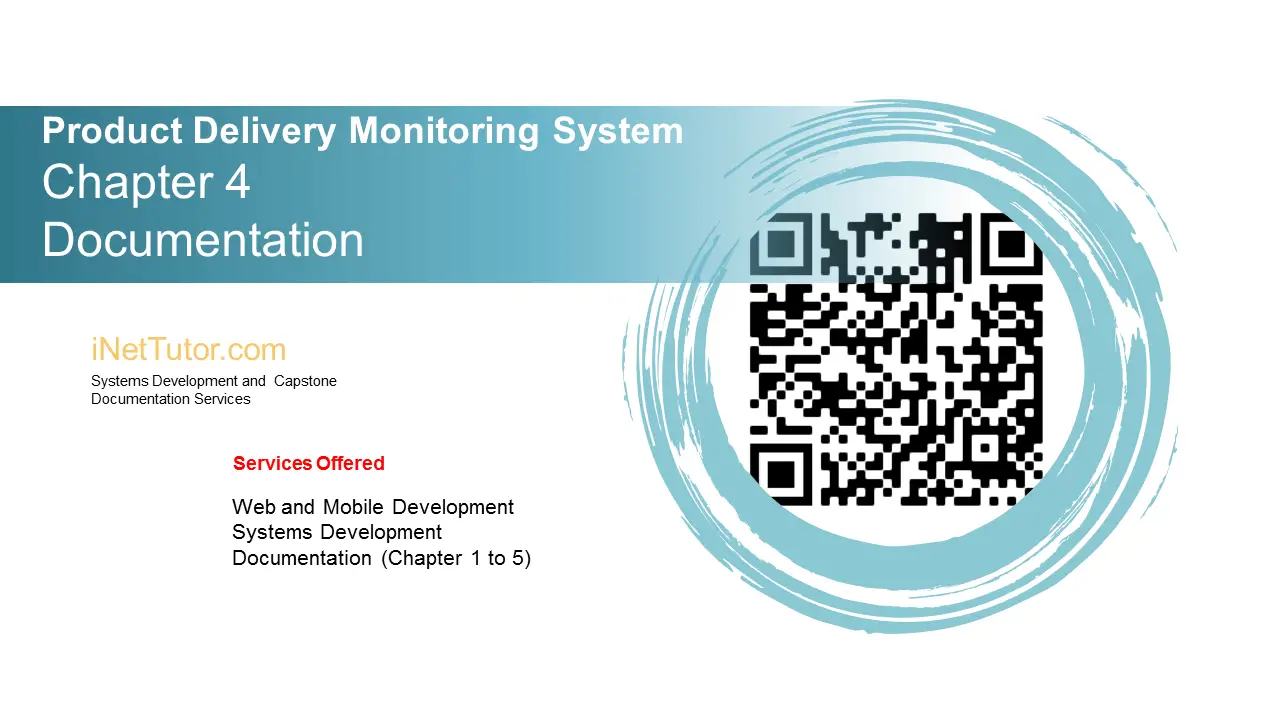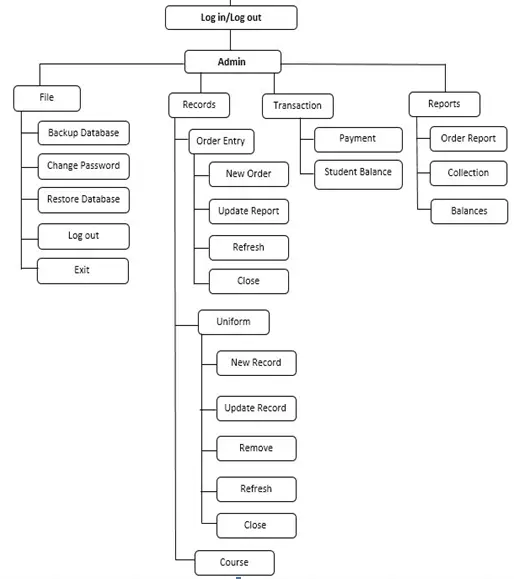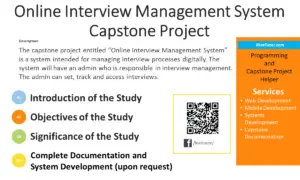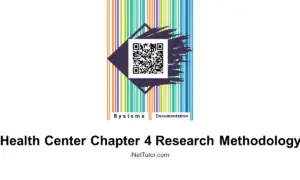Product Delivery Monitoring System Chapter 4 Documentation
CHAPTER IV
METHODOLOGY
This chapter presents the requirements analysis and documentation, design of software and processes, development method and testing, system prototype and description, implementation plan and results.
System Methodology
The researchers utilized the Systems Development Life Cycle (SDLC) method in the development of the system. The SDLC method was the process employed in the analysis and design of the PRODUCT DELIVERY MONITORING SYSTEM. The model develops systematically from one phase to other in a downward fashion, like a waterfall.
The following are the phases involved in the development of the Product Delivery Monitoring System (PRODUCT DELIVERY MONITORING SYSTEM):
Requirements Definition-This includes the methodology used to develop the system, the system’s functionality, and the project plan in developing the said system. It also includes the software and hardware requirements, software developer and people ware recommendations in the development of the system.
System and Software Design Phase-The proponents created a design for the system to be developed. All the requirements of the first phase are being used to contribute in the successful preparation of creating the new software. The proponents prepare the Data Flow Diagram, DFD Explosion for teachers and students.
Implementation and Unit Testing Phase-This phase discussed the implementation plan and results of Product Delivery Monitoring System. This phase also discussed if the recommended functions and suggestions of the stakeholders were met. The system was first developed in small programs called units. Each unit was developed and tested for its functionality; this is referred to as Unit Testing. Unit testing mainly verifies if the modules/units meet their specifications.
Integration and System Testing Phase-The developed system was integrated and testing would exercise the system in all possible ways.
Operation and Maintenance Phase-System operation includes user support to the end user or users. The system must provide product or service to the end users. Users should receive training especially the teacher. He or she could use the user’s manual or direct assistance from experts to support critical activities. The maintenance phase consists of maintenance-tasks to keep the product up and running. Maintenance is always necessary to keep system usable and useful.

REQUIREMENTS ANALYSIS AND DOCUMENTATION
This phase shows the requirements definition needed for the development of the Computer Based Product Delivery Monitoring System (PRODUCT DELIVERY MONITORING SYSTEM). It includes the requirements from the users using the survey questionnaires in order to achieve the recommended features of the Computer Based Product Delivery Monitoring System.
In order to develop Computer Based Monitoring System, the researchers need to make necessary preparation. Different procedures were made to attain the objective which includes the interviewing of Head of Economic Enterprise and also the Project Manager of the Business establishment.
The researchers ask questions to the Head and the project manager about the traditional way of transaction and monitoring of the product. The researchers also made investigation if this way of transaction and monitoring is effective to the students. Due to this, we established basis to learn its advantages and disadvantages, we also ask the head of economic enterprise and the project manager of Business establishment about his suggestions and recommendations to this type of transaction. By the help of the review of related literatures, the researcher had gained an overview of what has been studied by previous researchers and writers that gave discernment about the theories, and hypothesis and methodologies.
Through the help of the early research of the topic and online articles; the researchers were able to understand the need to continue the study and the effect of this in handling current problems applicable to this area.
The researchers present the software development tools, hardware specifications, and peopleware recommendations for the development of Computer Based Product Delivery Monitoring System (PRODUCT DELIVERY MONITORING SYSTEM).
Software Requirements. The software development tools used by the researchers in this project are presented in Table 1.0.
Table 1.0
Software Requirements
| For Software Development | |
| Operating System | Operating system such as Windows XP/Vista/7/8/10 |
| Database | Microsoft Access is the database management system tool to be used as the back end database of the system. |
| Programming language | Microsoft Visual Basic Professional/Enterprise |
| Documentation | Microsoft Word 2007 |
Hardware Requirements. The researchers presents the minimum hardware resources necessary for the utilization of PRODUCT DELIVERY MONITORING SYSTEM is presented in Table 2.0
Table 2.0
Hardware Requirements
| Processor |
Pentium 4 or higher |
| Memory |
512 MB RAM or higher |
| Disk Storage |
40GB |
|
Others |
DVD-ROM Drive Standard Keyboard USB/PS2 Optical Mouse AVR/UPS 120volts 15”/17” LCD/LED monitor
|
Peopleware Recommendation. Peopleware refers to persons involved in the development of the system with specific task is given in Table 3.0.
Table 3.0
Peopleware Recommendation
| Software Developers | Job Responsibilities |
|
Programmer
|
The programmer who has sufficient knowledge on Microsoft Visual Basic 6.0. He/she is needed for he/she will be in charge with the design and implementation of the system. He/she should also have knowledge about Microsoft Access for him/her to add, edit, delete and manipulate his/her way through the database. In times that the computer malfunctions, he/she should also know the basics on troubleshooting.
|
| Recommended Users | Functions |
|
Business establishment Personnel
NONESCOST Students |
The Business establishment personnel who will encode the data gathered from the student who has the transaction to the bookstore about their uniform.
The students of Northern Negros State College of Science and Technology (NONESCOST) for they will be the beneficiary of the PRODUCT DELIVERY MONITORING SYSTEM (PRODUCT DELIVERY MONITORING SYSTEM).
|
DESIGN OF SOFTWARE AND PROCESSES
This phase includes the processes of the software used in the developed system (PRODUCT DELIVERY MONITORING SYSTEM) which includes the system functionalities, discussion and illustration of the Decomposition chart, Data Flow Diagram, and Entity Relationship Diagram.
System Functionality
Business establishment Personnel – The Business establishment Personnel is the authorized user who will manage the system and have full access to the system. She/he updates transactions of students, updates orders, and view and prints reports.
Student – The students are provided with a fast and accessible product delivery monitoring system. Data generated by the developed system is accurate and updated.
The researchers present the data flow diagram and the decomposition diagram of the system which show the procedures of each function, the users and the expected outputs of the developed system.

Figure 1.0 Decomposition Chart of PRODUCT DELIVERY MONITORING SYSTEM
The PRODUCT DELIVERY MONITORING SYSTEM shall be used by the Business establishment personnel. Under the Admin are the features: The File menu (shows the Back-up Datafrom the database, Change password for the account, Restore Database, Log-out and Exit), The Records (shows the order entry of the registered students,uniform information, and Course), The Order Entry (shows the New Order for the student, Update Report for updated data for the order of the student, Refresh, and Close), and The Uniform(shows the New Record of uniform, Update Report for the updates of data about the uniform, Remove, Refresh, Close). The Transaction (contains Payment of the Student, Student Balance), The Reports (contains Order Report for all uniform of the Student who order, Collection Report for the total collection income of the Business establishment, and maintaining balance of students).
Data Flow Diagram of PRODUCT DELIVERY MONITORING SYSTEM
The Data Flow Diagram shows the graphical presentation of the flow and processes of data in the system. The student will give the data about his /her order and payment transaction to the Business establishment personnel that will be encoded in the system, the supplier also give the price list to the Business establishment personnel for encoding in the system after the data was inputted in the system it will automatically generate all the reports like order, collection and student balance that will be passed to the Economic Enterprise and order report for supplier also the system can automatically display the balance of the students for the clearance purposes.
The ERD illustrates the Entity Relationship Diagram of the developed system. In order for the Business establishment personnel to access the said system they need to log in the username and password, in order to manage the content of the system. The entity relationship diagram shows using Product Delivery Monitoring System, the personnel input order, process payment in the system store/generate reports, and view student balance.
DEVELOPMENT AND TESTING PHASE
The following are the requirements needed in developing Product Delivery Monitoring System. It includes the three components of the computer system which are the software, hardware and peopleware.
Software Requirements:
- Operating system such as Windows XP/Vista/7/8
- Programming language: Microsoft Visual Basic 6.0 Professional/Enterprise
- Database: Microsoft Access is the database management system tool to be used as the back end database of the system.
Hardware Requirements
- Pentium 4 or Higher
- 512 MB RAM or higher
- 40 GB Hard Disk or Higher
- DVD-ROM Drive
- Standard Keyboard
- USB/PS2 Optical Mouse
- AVR/UPS 120volts
- 15”/17” LCD/LED monitor
Peopleware Requirements:
Peopleware refers to persons involved in the development of the system
- The programmer who has sufficient knowledge on Microsoft Visual Basic 6.0. He/she is needed for he/she will be in charge with the design and implementation of the system. He/she should also have knowledge about Microsoft Access for him/her to add, edit, delete and manipulate his/her way through the database. In times that the computer malfunctions, he/she should also know the basics on troubleshooting.
Before developing the system, the researchers conducted an interview to the intended beneficiary if there is a need in the Business establishment for such system. Unit testing, integration testing and system testing were conducted first to test if the researchers develop the right system. Then, testing such as expert testing and user acceptance or final testing was conducted.
Each part of the system had to be separated in unit testing. Each part had to be tested individually if it is working properly as it should. After unit testing, integration testing follows. Its main purpose is to test if the software units are compatible with each other. Also in integration testing, any inconsistencies are detected between the software units that are integrated called assemblages and/or between the software units and the hardware.
System testing is performed after all the integrated software and hardware components have successfully passed integration testing. After this, the researchers made an evaluation and conducted the expert testing and user acceptance or final testing in order to test the reliability of the system. In the expert and final testing, the researchers asked the experts and intended users to try and use the system to test its functionality.
In software testing, the researchers gathered data from the Business establishment Project manager and the head of economic enterprise who were the respondents of the study. Based from those gathered data, the researchers came up with a solution and developed a system that was evaluated first by the NONESCOST Economic Enterprise Head and Business establishment project manager and was used as the overall reference and basis for the PRODUCT DELIVERY MONITORING SYSTEM (PRODUCT DELIVERY MONITORING SYSTEM).
Expert Testing
The developed Product Delivery Monitoring System was evaluated using the McCall’s Software Quality Model Evaluation Form (See Appendix F). The evaluation was conducted by three (3) experts from the Northern Negros State College of Science and Technology (NONESCOST) to determine if the new software “Product Delivery Monitoring System” had passed the Software Quality Standards.
User Acceptance
The User-Acceptance was conducted to the intended respondents after the Expert Testing using the User’s Acceptance Evaluation Form survey questionnaire (See Appendix H).The purpose is to test the reliability and functionality of the developed Product Delivery Monitoring System and if the demanded features were met.
The respondents of this study were the Business establishment personnel who will process the transaction in the Business establishment.
The researchers used purposive sampling or judgmental, selective or subjective sampling, is a type of non-probability sampling technique, purposive sampling subjects are selected because of some characteristic. Patton (1990) has proposed the following cases of purposive sampling. Purposive sampling is popular in qualitative research.
The researchers conducted a survey to the Head of Economic Enterprise and the Project manager of the Business establishment.
IMPLEMENTATION PLAN
The researchers conducted a system dry-run and conduct training of the target users of the system. The users of the system checked and evaluated the system if the recommended functions and suggestions of the users were met.
Initial testing and final testing was conducted by the researchers. The researchers plan to integrate the Product Delivery Monitoring System and the following are the requirements for implementation of the Product Delivery Monitoring System
- Software Requirements
- Windows Operating System – Windows 7(minimum)
- Peopleware Requirements
Personnel – Being the people who are in-charge in bookstore that who will be doing for the transaction for the students using the Product Delivery Monitoring System, they must be trained and oriented on how to use the system properly.
IMPLEMENTATION RESULT
After conducting an investigation, the result of the evaluation was presented (see Appendix G). The developed system was evaluated by three IT Experts/Programmers using the Software Quality Model based on the criteria set forth by McCall’s. The Product Delivery Monitoring System has an overall weighted mean of 3.7, which was descriptively rated as good, only shows that it is credible.
Based on the user acceptance testing or final testing results gathered, it was proven that the Product Delivery Monitoring System is reliable having an overall weighted mean of 4.3 which has a descriptive rating of Excellent.
With the findings presented above, it shows that the Product Delivery Monitoring System adheres to the standards of software development. The results show that the PRODUCT DELIVERY MONITORING SYSTEM is effective and useful as an alternative way of traditional transaction based of ordering, payment and monitoring.
Credits to the authors of the project.
You may visit our facebook page for more information, inquiries and comments.
Hire our team to do the project.


